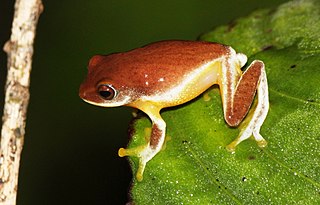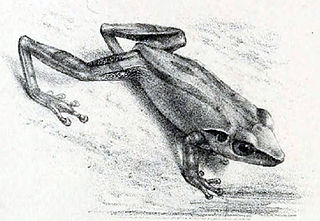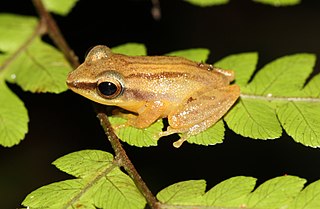Weerahannadige Francisco Fernando alias Puran Appu is one of the notable personalities in Sri Lanka's history. He was born on 7 November 1812 in the coastal town of Moratuwa. He left Moratuwa at the age of 13 and stayed in Ratnapura with his uncle, who was the first Sinhalese proctor, and moved to the Uva province. In early 1847, he met and married Bandara Menike, the daughter of Gunnepana Arachchi in Kandy. He was captured by the British after the failure of Matale Rebellion along with Gongalegoda Banda and Ven. Kudapola Thera. He was executed by a firing squad on August 8, 1848. His body was buried in Matale.

Pseudophilautus asankai, commonly called Asanka's shrub frog, is a species of frogs in the family Rhacophoridae.

Pseudophilautus auratus, commonly called Golden shrub frog, is a species of frog in the family Rhacophoridae, endemic to Sri Lanka.
Pseudophilautus dimbullae is an extinct species of frog in the family Rhacophoridae. It was endemic to Sri Lanka. It is only known from the holotype collected in 1933.
Pseudophilautus eximius is an extinct species of frog in the family Rhacophoridae. It was endemic to Sri Lanka. It is only known from the holotype collected in 1933.
Pseudophilautus extirpo, known as Blunt-snouted Shrub Frog, is an extinct species of frog in the family Rhacophoridae. It was endemic to Sri Lanka. It is only known from the holotype collected in 1882. The specific name extirpo is Latin meaning "destroy" or "eradicate" and refers to the apparent extinction of this species.
Pseudophilautus halyi, known as Pattipola Shrub Frog, is an extinct species of frog in the family Rhacophoridae. It was endemic to Sri Lanka. It is only known from the holotype collected in 1899. The specific name halyi honours Amyrald Haly, the first director of the Ceylon Museum, author of the "Natural History of Ceylon", and the collector of the holotype.

Pseudophilautus hypomelas is a species of frog in the family Rhacophoridae endemic to Sri Lanka. It is sometimes referred to as the webless shrub frog. In 2004 it was declared extinct by the International Union for Conservation of Nature when, despite extensive field efforts, no specimen had been seen in the wild after the species was described by Albert Günther in 1876. However, this frog was rediscovered in 2010 in the Peak Wilderness, a highly biodiverse area in the Central Highlands of Sri Lanka. Thus, this species had been "lost" for more than 130 years.

Pseudophilautus schmarda is a species of frog in the family Rhacophoridae. It is endemic to the central hills of Sri Lanka and is known from the Peak Wilderness Sanctuary, Agra Bopath, Horton Plains, and Pedro. The specific name schmarda honours Ludwig Karl Schmarda, an Austrian physician, naturalist, and traveler. Common names Sri Lanka bug-eyed frog and Schmarda's shrub frog have been coined for it.

Pseudophilautus stictomerus is a species of frog in the family Rhacophoridae. It is endemic to Sri Lanka. It was first described by Albert Günther based on a single individual collected by Colonel Richard Henry Beddome from 'Ceylon'.

Pseudophilautus viridis, or the dull-green shrub frog, is a species of frogs in the family Rhacophoridae. It is endemic to Sri Lanka and occurs in the central hills of south-central Sri Lanka.
Pseudophilautus zal, known as White Blotched Shrub Frog is an extinct species of frogs in the family Rhacophoridae. It was endemic to Sri Lanka. It is only known from the type series consisting of three old museum specimens.
Pseudophilautus pardus is an extinct species of Sri Lankan shrub frogs in the family Rhacophoridae. Despite extensive surveys in recent years, the species is known only from a collection made prior to 1858. The reason for its extinction is unknown but probably relates loss of forests.

Pseudophilautus semiruber, known as Annandale's Shrub Frog, is a species of frog in the family Rhacophoridae that is endemic to Sri Lanka.
Pseudophilautus bambaradeniyai is a species of frogs in the family Rhacophoridae, endemic to Sri Lanka.
Pseudophilautus hankeni, the Hanken's shrub frog, is a species of frogs in the family Rhacophoridae, endemic to the Knuckles Mountain Range, Sri Lanka.
Pseudophilautus newtonjayawardanei is a species of frogs in the family Rhacophoridae, endemic to Sri Lanka.

Sri Lanka petite shrub frog,, is a species of frogs in the family Rhacophoridae, endemic to southwestern Sri Lanka. This relatively recently described species is only known from two locations in the Galle District, Beraliya and Kanneliya Forest Reserves. The specific name tanu is Sinhalese for "slender" and refers to the habitus of this frog.
Pseudophilautus sirilwijesundarai is a species of frogs in the family Rhacophoridae, endemic to Sri Lanka.

Pseudophilautus dilmah, the Dilmah shrub frog, is a species of frogs in the family Rhacophoridae, endemic to Sri Lanka. The species was discovered and documented in 2015 by Sri Lankan prominent wildlife researcher and herpetologist Mendis Wickramasinghe and his crew from Loolkandura forest of Central highlands of Sri Lanka. It is distinguished mainly from other shrub frogs by the absence of nuptial pads and anterior and posterior dorsum without horny spinules.










